If you want to raise your content writing rates, but you are afraid that they may be too high or too low, I have good news.
In this article, you will learn:
- The seven factors that define your content writing rates (it’s not just your experience)
- How much you could be charging (it’s probably more than you currently do)
- How you should charge your clients (hint: it’s not per word)
Let’s get started.
How to Define Your Content Writing Rates
Writing Experience
Experience, or lack thereof, plays a key role in your content writing rates. The more experienced you are, the more you can earn, and vice-versa.
This rule applies to writing as to any other skill. As your writing skills improve, your content will improve likewise.
Salary comparison site Payscale, shows the way rates change for US-based freelance writers according to their experience:
- Beginners with less than a year worth of experience earn an average of $19.25 an hour.
- Early-career writers with one to four years of experience make $20 per hour.
- Intermediate writers with five to nine years of experience earn, on average, $29.29 per hour.
- Experienced writers with more than ten years earn $34,13 per hour on average—those with 20+ years make an average of $49 per hour.

Clearvoice shows a similar relationship between experience and rates, with most beginner and intermediate writers charging between $0.01 to $0.50 per word, and “professional” and expert writers charging from $0.50 to more than $1.00.
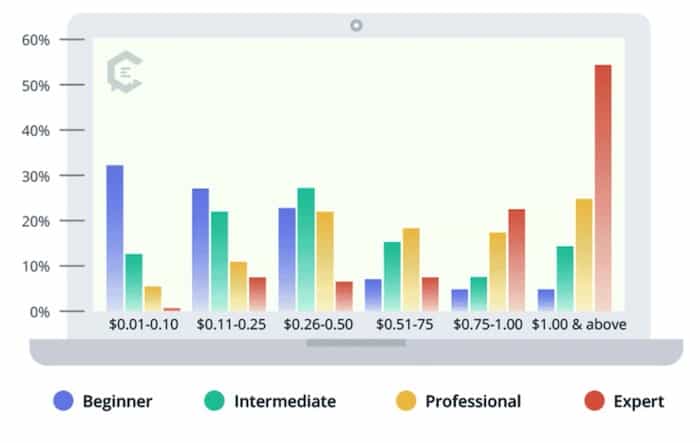
If you’re just starting, I recommend starting with $0.10 per word. This is only a bare-minimum suggestion; I started charging $0.20 per word because I had experienced writing and doing marketing.
Complexity
The complexity of the work required also affects your content writing rates. Some of the factors that define a work’s complexity include:
- Research: The more research your content requires, the more time it will take you to create it.
- Interviews: These take time, especially if you have to research the interviewee and the right questions to ask.
- Quotes: This involves finding the right people to quote, emailing them, editing the answers, and adding them to your content.
- Graphic design: Creating graphics is a separate skill cost more. If you have to use a tool like Adobe Photoshop or Canva, you also deserve a higher rate.
In every case, you should compute the complexity in your rate calculation and increase them accordingly.
These tasks don’t affect your rate because they require more time; that’s irrelevant to your client. What matters is that they add value to your content. As you will see later on, you want to charge based on value, not time.
If you want to increase your rates fast, take research seriously. The more you have to do to write a piece, the more you can charge. It’s a small effort that can increase your profits significantly.
Technicality
Complex content based on technical concepts and ideas—ideas that require time to explain—will increase your content writing rates.
Unlike content writing, which you can easily learn in a few months, technical writing is a skill of its own. It requires understanding complex concepts, breaking them down, and explaining them to less technically-apt crowds.
Some technical fields that affect the rates positively include:
- Coding
- Design
- Mechanics
- Electricity
- Medicine
If you have technical skills, make sure to leverage them in your career.
Location
In theory, your location shouldn’t be a factor in your content writing rates. Whether you are Malaysian, Indian, American, or Brazilian doesn’t matter; what matters is that you write great content.
Sadly, this fact doesn’t apply for many writers, either because:
- They think they can’t command higher rates from economically-underdeveloped countries, or because;
- The companies that hire them think they can only pay high rates to writers from economically-developed countries.
Costs of living do affect wages. For example, Buffer, a fully remote software company, uses location as one factor in their salary calculator.

This mostly affects writers working as employees. But when you are a freelancer, your location is secondary because your clients hire you for your services.
You can choose to let your location affect your rates, but it’s not necessary. If a client ever tries to lower your rates due to your location, consider that client gone. That should never be a topic of discussion, just as your age, gender, or skin color.
If your location or nationality ever becomes a topic of discussion, clarify that it’s not. All that your client should care about is your content’s quality. If you can deliver on your promise, then there’s nothing to discuss. Don’t let your clients bully you into lowering your costs due to it.
Content Type
There is a long list of content types writers can create:
- Blog posts
- Emails
- Ebooks and white papers
- Video and webinar scripts
- Social media content
- Sales letters
Content types like blog posts and social media content tend to be cheaper as they are less complex. They are also the farthest to the sale, which downgrades their importance.
Emails, ebooks, and sales letters, in contrast, play a greater role in sales. This increases their market value significantly.
As a rule of thumb, the more complicated the content type, and the closest it is to a sale, the higher your content writing rates.
If you are a beginner, start with blog posts, but try to move up to the other sales-focused content types as soon as possible.
Client Relationship
There are two types of client relationships you can have:
- Direct: The client works with you without any intermediaries. They either contact you because they want to work with you, or you contacted them and hired you.
- Indirect: The client uses an intermediary to hire you. That’s the case of freelance marketplaces, gig sites, agencies, and content mills.
The benefits of using an intermediary like Upwork or Fiverr is that a freelance content writer can focus on their work and not on client acquisition. The problem is that:
- They take a fee, lowering your profit margins.
- They incentivize a race to the bottom between writers—clients focus on costs and not quality—lowering your margins even further.
That’s not to say there are no benefits to these companies. New freelance writers can benefit by giving them experience and a client base quickly, but they shouldn’t be part of your business strategy as they are not sustainable.
Working directly with clients allows you to command higher rates. You become an equal in the relationship with your client, even if you are the one reaching out to them. What’s more, you can get repeat work and referrals, both highly profitable business tactics.
If you are starting, you can use Upwork and other freelance sites. But as soon as possible, aim to start your writing site and attract clients there through SEO and email outreach.
Audience
The audience to which a writer works for plays an essential role in their content writing rates. Broadly speaking, we can segment an audience into two groups:
- Beginners: People who have little experience or knowledge for a given topic.
- Advanced: People who have experience and knowledge.
More technical and experienced audiences require more expertise. The more expertise you have, the scarcer your skills, and thus, the higher your rates.
If all you write is “beginner guides” or “101 tutorials,” and you wonder why you can’t make more money, it’s your audience. Aim to write for advanced audiences, and you will command higher rates.
To write for advanced audiences, specialize in one industry. The more you write, the more you will learn, and the easier it will be two cover advanced topics.
Does Gender Affect Rates?
Sexism is an ever-lasting factor in any wage-related discussion. In theory, you would expect that female freelance writers had lower rates than men as it happens in almost every industry.
As surprising as this may seem, a ClearVoice survey found women charge an average of 11.7% more per word and 8.3% more per hour.
The company doesn’t explain why this happens, but it’s a shocking fact nonetheless.
How Much Can You Expect to Earn?
We could talk a lot about how much you could charge and how much you deserve to make, but that would be nothing but fluff.
Let’s look at what actual content writers make in real life and what you can expect to make.
The salaries I show below apply mostly to content writers who work as employees. Still, you can use the data in your freelance writing business. After all, these are market-based prices.
Content Writer Salary
Payscale shows that US-based freelance writers make an average of $24.22. The lowest 10% of writers charge as little as $12.02, while the highest 10% charges above $63.22.

The average annual salary is $39,555. The lowest 10% generate $15,000, while the highest 10% make $76,000. Since the lowest 10% makes less than minimum wage, we can assume that these prices are for part-time workers, and vice-versa with the highest-paid writers.
Taking bonuses, profit-sharing, and commissions in place, the total pay ranges between $24k to $117k. I have never heard of these bonuses in freelance content writing, but that can be something to consider in your calculations.
Ziprecruiter shows the average annual salary is $63,213, and ranges go from $25,000 (25th percentile) to $75,000 (75th percentile).
Ziprecruiter shows the average rate is 25% higher than Payscale’s. However, that’s taking the average, which includes the outliers. The distribution shows a closer number to Payscale’s, with most rates being closer to the $25 per hour range.
Content Writer Hourly Rate
As a comparison, Payscale shows that US-based freelance copywriters make an average of $29.29 per hour, with prices ranging between $14.57 to $72.72.
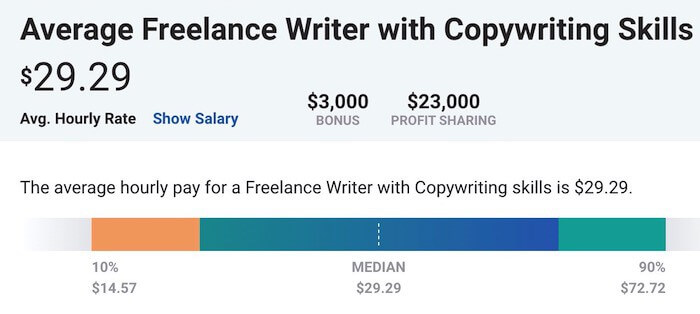
On the other hand, Payscale shows that freelance editors make an average of $25.04 per hour, with rates ranging from $12.51 to $65.64.
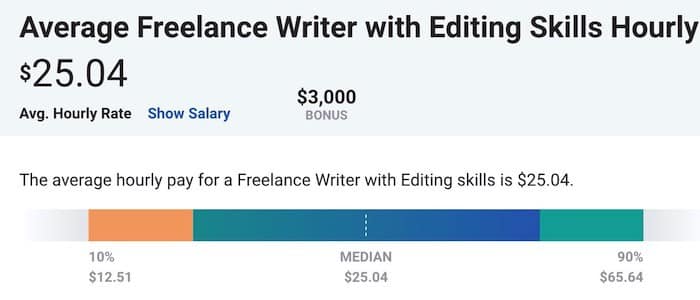
Payscale shows little difference between freelance content writers and editors, with the former making 80 cents less than the latter.
Unsurprisingly, copywriters make 20% more than both content writers and editors.

As a point of reference, Payscale data from freelance content writers from several countries, including:
- Australia: The average hourly rate is AU$32.50 (U$S23.94).
- Canada: The average hourly rate is C$24.63 (U$S18.79).
- United Kingdom: The average hourly rate is £20 (U$S26.70).
This data shows that Australian content writers make the same as their American counterparts, while Canadians make 22% less than Americans. On the other hand, the British make 10% more than Americans.
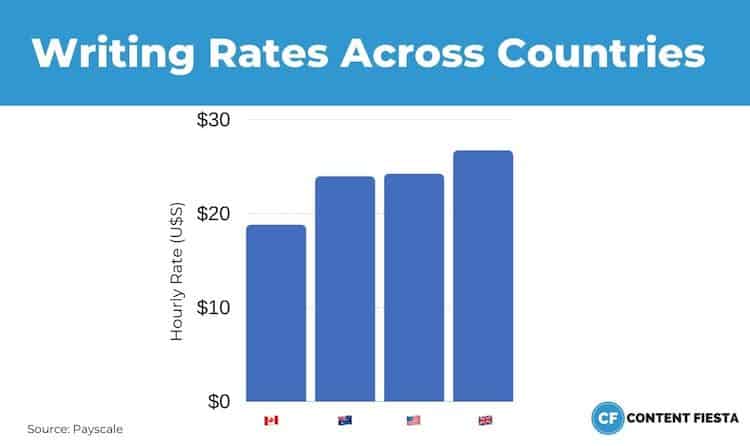
Ziprecruiter shows the average hourly rate for US-based freelance content writers is $30 per hour.
Breaking the data further, we can see:
- 18% of writers make between $5.29 to $11.78. (The company states these writers are the exception, not the rule.)
- 12% make between $11.78 and $18.27.
- 16% make between $18.27 and $24.76.
- 20% make between $24.76 and $31.25.
- 14% make between $31.25 and $37.74.
- 8% make between $37.74 and $44.23. (The company states these rates and the following ones are the exceptions, not the rule.)
- The final 8% make between $44.23 to $76.68.
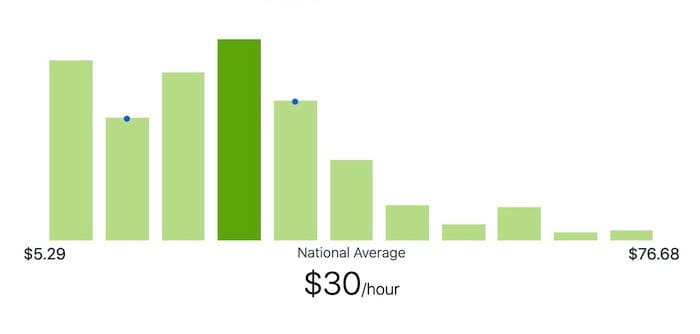
What Is a Good Hourly Rate for a Freelance Writer
The question you may be asking yourself is, “what’s a good hourly rate I could charge my clients?“
If you work in the US, or for US-based companies, then your rates could be anywhere from $15 to $30 per hour. Remember to adjust them based on to the factors described at the beginning. For example, if you don’t have any writing experience, then this will affect your rates. The same applies to the content types you specialize in, your client relationship, and more.
If you work for companies that aren’t located in any of the countries mentioned above, consider lowering or increasing your rates accordingly.
Freelance Writing Rates per Word
Clearvoice data shows that freelance content writers make the following per word:
- 14% of writers make between $0.01 to $0.10.
- 18% make between $0.11 to $0.25.
- 18% make between $0.26 to $0.50.
- 13% make between $0.51 to $0.75.
- 25% make between $0.76 to $1.00.
12% of writers surveyed didn’t indicate their per-word fee because they didn’t use it as a pricing method (smart people, I’d say).
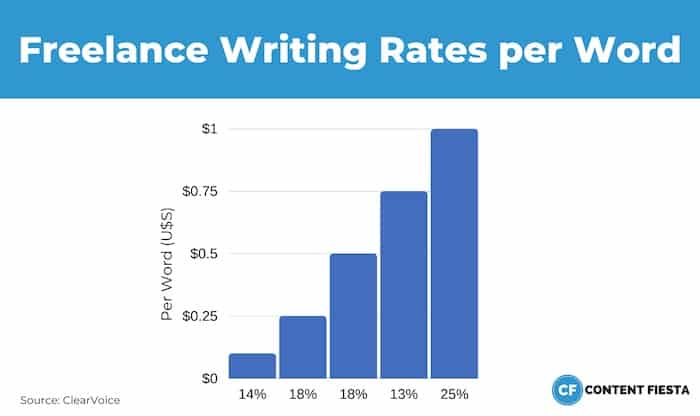
Clearvoice data is harder to compare with the previous one as I can’t translate the per-word pricing to per-hour or yearly wages.
Still, it shows that a quarter of writers charge high rates, and another quarter charge from low to medium rates.
Overall, Clearvoice differs the most from the other two sites but offers interesting data.
How to Charge: Per Word, Per Project, or Per Hour?
So far, we covered the factors that affect your rates and the market values for your writing services. The last point we need to discuss is the way you can charge your clients.
There are three ways freelancers can charge their clients:
- Per word
- Per hour
- Per project
Each of these three methods has its advantages and disadvantages, which deserve a discussion of their own.
Let’s take a look at each of these three pricing methods so we can then define which one is the best for you.
There are other pricing methods, like retainers, value-based, and profit-sharing, but these are more advanced and don’t even apply for writers and these three methods.
Charge Per Word
Pros:
- Ideal for beginners who want a simple pricing method. At an early stage, your clients may not trust you due to your small or nonexistent writing portfolio. By charging per word, you promise the client that you charge by performance.
- Your clients get a clear cost-benefit relationship. They can lower their costs by reducing your word volume, and they will not get any surprises in their bill.
- Your clients can easily compare you and make a cost-based decision. If your price is low or competitive for your quality, they will make an easy decision.
Cons:
- There’s a blurred line between cost and benefit. What’s the difference between a $0.20-per-word writer and a $0.30-per-word one? Some factors correlate with higher fees, as shown before, but none explain causation. Consequently, with per-word pricing, you can end up undercharging your clients.
- The more edits, research, interviews you have to do, the less you earn. You can override this issue by increasing your price per word accordingly.
- You focus on words, not output—that is, quality content.
Conclusion: Per-word pricing is ideal for a new freelance content writer. It’s what I used, and it helped me get started.
As you progress in your career, you want to switch to any of the other two methods. Remember: your clients want quality content and results, not words on a page.
Charge Per Project
Per-project pricing means you charge a flat fee for a predefined type of content—something that’s called the “scope” of the project. For example, my per-project fee starts at $500 per article for 1,500 words. That’s the scope of my services for articles; more complex projects cost more.
Pros:
- You focus on the output, not on the words you write.
- Ideal if you offer more than content. For example, you could add promotional, editing, or design services to your services and increase your average sale value.
Cons:
- The client can’t see what they get clearly. They may discuss the reason why you charge what you charge. They may also want changes in your offer to lower their costs.
- Scope creep. You can end up offering more than you get paid for either because you didn’t think your offer well or because your client pushed you to add more services to it.
Conclusion: Per-project pricing is what I and most professional content creators use. Once you know the time it takes you to create content, you can define a project fee that guarantees a healthy margin and a high hourly rate.
Charge Per Hour
Pros:
- You maximize your value per hour, if you are efficient. You can use a calculator to find your ideal hourly rate.
Cons:
- Clients may worry you will overcharge them. They will discuss and negotiate every little task you do to minimize their content marketing costs. If you can’t explain the time you spend creating your content, you can get in trouble with your client.
- You must be efficient; otherwise, you risk hurting your client relationship.
Conclusion: Hourly rates aren’t standard among freelance content writers as most spend a similar amount of time per content.
After a while, you get a feeling of the time it takes you to create, say, an article, ebook, or email sequence and use a per-project fee based on your hourly rate.
Hourly rates are better suited when you offer a monthly retainer. Since I don’t cover this one, then I’d steer away from hourly rates.
Define Your Content Writing Rates
If you are looking to define your content writing rates, then here’s what you need to know:
- The more experienced you are, the more you focus on content close to sales (like copywriting and ebooks), and the more complex the project, the more you can charge.
- Aim to work outside freelance marketplaces; develop your writing site, and attract clients there. Focus on building relationships with your clients so you can get repeat and referral work.
- Per-project fees are better than per-word. Per-hour pricing isn’t common, although you can use it to base your project fees.
- English Native speakers from countries like the US and Australia make an average of $25 per hour, while Canadians make 22% less than them, and British writers make 10% more. If you live outside these countries, you can adapt your fees accordingly. But remember, your location shouldn’t be the only factor you take in your calculations. What matters is your content quality, not where you live.
These writing rates are only a point of reference. If you can develop your brand and provide a unique, high-value service to your clients, you can charge as much as you want.
